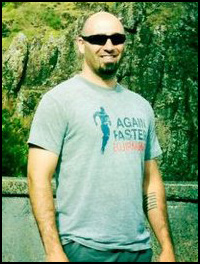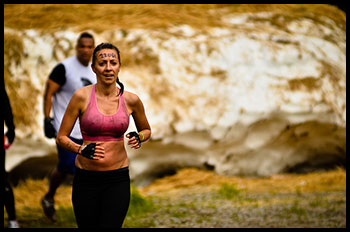Spartan Races. Tough Mudder. Warrior Dash.
Obstacle course races (OCRs) are taking the fitness world by storm with their combination of varied terrain, changes in elevation and climate, and, of course, seemingly torturous obstacles. For box goers who pride themselves in training for the unknown, there is certain synergy to these types of races. Like a challenging WOD, the race course is varied, requiring participants to dig deep, ignore pain, and face fear as they move through the obstacles.
As with box programs, power and strength are key, but so, too, is technique. Weaknesses are quickly exposed; there is no place to hide. Just as Affiliate programs are replacing traditional globo gym training, the newest versions of obstacle course racing are edging out their more conservative cousins such as triathlons.
How do Affiliate programs and OCR work together?
Climbing, jumping, running, and hanging on for dear life are what athletes do every day. Obstacle course racing allows box goers to test their skills outside the box. While the physical and mental demands are not much different than an arduous CrossFit WOD, there are key differences to consider: the terrain, the climate, and the unknown. While many of us are familiar with “Murph” and “Glen”, it is unlikely we do those workouts on a steep mountainside or as we climb through a riverbed.
If your box is offering OCR training for an upcoming event, consider breaking down the training into phases according to the race. Consider how much time you have before the race. 12 weeks? 8 weeks? Prioritize your training based on the amount of time you have to prepare your athletes for the race. The longer the time out, the more strength work you will want to do before increasing the run mileage. Don’t have much time? Focus on the running and obstacles.
Here in the Northeast, the start of the OCR season kicks off with the Tough Mudder in June. Most of your athletes will not be looking to hit this 10k+ challenge as their first foray into OCR. Most will start with something like a Spartan Sprint or Warrior dash. Some of the smaller locally run races may be a bit hit or miss or in some cases downright dangerous, so I suggest you steer your newbies towards a highly professionally run OCR like the Spartan Races.
Building a base
Distance:
The first thing we look at is the race’s distance. Is it a 5k, 10k or more? In box programs most WODs only have ½ to 1 mile of running involved. While intense, doing just the WOD will not fully prepare your athlete for the rigor of trudging uphill for one to three miles. Planning a long group run once a week, while increasing mileage over the course of training, is a good idea. Adding runs to the regular WODs is also helpful. Your goal is to help build the team mentality and team cooperation needed in an OCR. If your athletes are unable to hit a group run, prescribe them homework to get the longer runs in when they can.
You want your athletes able to get through the running so they are fresh for the obstacles and able to deal with the mental hurdles that come with tough uphill running. When running is easy the obstacles are fun. Increase the grade and elevation of the runs as you progress closer to the race. However, I recommend you taper off two weeks out.
We are fortunate as our affiliate is close to a state reservation; we have access to both smooth and rocky terrain on which to run and prepare for OCR races. I suggest mapping out a few trail or hill runs ahead of time (1k/5k/10k courses) as well as locating a ski mountain that you can get to once or twice before a big race to practice the hard uphill work.
Most OCRs are 5k in distance but the first mile/1k is usually uphill, muddy and meant to tire you out before the obstacles. In the 10k’s it is the first three miles and sometimes a hard mile up and down in the middle. Make sure your athletes are prepared to grind out a long uphill battle at the start. After that it is usually only ½ to 1 mile between obstacles. This is where members will feel most comfortable.
Movements to incorporate in WODs for uphill conditioning:
- Front Squats
- Back Squats
- Mountain climbers
- KB Swings
- Lunges (Walking and add weight, use sandbags if possible)
- Step ups (weighted with barbell, sandbag, buckets with sand, Increase box height over training)
- Bear crawls and crab walks (start on a flat surface then incorporate small to medium incline up and down hill work)
Strength:
If you have 12 -16 weeks to prepare for the OCR, I suggest a 4 – 6 week strength cycle at the beginning. This will bring your new people up to speed on the strength needed for the uphill work to come. I suggest something like 5/3/1 as it is a percentage based program that usually takes awhile to plateau with and works well with conditioning work like a metcon or accessory work like OCR specific skills after it.
Obstacle Specific Training
Are your athletes afraid of heights? Never climbed a wall before? How about a rope climb or tire flip? There are some specific things you as a coach may need to address so your athletes are not skipping obstacles and incurring penalties*.
Working closely as a team can be one of the best ways to help someone get over a fear, especially the high walls. While most people are really friendly and helpful at these races it is best for your athletes to know they have a support system. Make sure they know it is a team event and that you will stay together for the obstacles. If you have many athletes running the race make sure they are in groups of no less than three. The eight-feet or higher walls may require three people to get everyone over. Having teammates is also beneficial if an injury occurs.
The high-risk and high-skill movements should be taught just like a skill session. Slow, controlled and with no pressure or time attached to it. For example, wall climbs, cargo net climb, rope climb, and in some cases a tire flip. This would be similar to teaching the O-Lifts with PVC. After proper technique has been demonstrated you can add them into the WODs or create small O-Courses for the workouts.
* Note: In some of the OCRs there is a penalty for skipping obstacles (usually up to 30 burpees). The burpees can suck time and fun out of the race. Prepare your members to be able to get 30+ burpees without an issue, just in case.
Obstacle Specific Movements to incorporate in WODs:
- Army/low crawl
- Shrimping
- Side rolls
- Crawl over/under/through objects
- Jumping (on, over, onto and from object to object)
- Low 4’/Med 6’/High 8’ wall climbing
- Rope climbs
- Tire flips
- Sled pull/push
- Monkey bars
Cold, Muddy and Fun
The OCRs are pretty famous for being cold and muddy. Most of the time you do not need to train in the cold and mud but you may need some strategy and good gear. If you are in an area that has some snow a few short outdoor workouts may not be a bad idea just be smart about it.
The first strategy is not to actually run when its really muddy or in water over your ankles. It is best to conserve your energy for flatter land and save your ankles a trip to the hospital. The mud and water will wash away topsoil to leave rock and uneven ground hidden beneath it, especially if you are in a later wave start time.
Investing in some good mud run sneakers is a great idea. They are built for traction in the mud and that will save some energy for the running. I like the inov-8 Talon’s but they also just released a new mudclaw specifically for OCRs. There are a few other companies out there with mud sneakers so read up on the reviews.
I suggest good compression gear (long sleeve top and bottom) if the weather is still a bit cold. This will help get the water off your body and keep the mud from drying onto you. The water obstacles vary from race to race but most of them involve ice water baths, cold rivers or jumping into and swimming through lakes. So make sure your athletes are prepared to be cold and swim a short distance.
Be prepared to throw some clothes like a shirt or socks away after the race. Bring a towel or two for changing after the race.
Creating an OCR Specific WOD
Here is a sample OCR WOD for an athlete that has done the running and skill work and preparing for a 5k OCR:
Warmup:
- Full range of motion joint warm up and flexibility work
- Dynamic warm up
- Bodyweight movements (push/pull/squat/jump/crawl)
Skill:
- wall climb technique – mindfulness over speed
- getting up, transition over safely, getting down safely, team work
- 4’ wall, 6’ wall, 8’ wall
WOD:
scale as needed
3 RFT
- 1 mile (1600m) run w/ sandbag (20/10#)*
- 10 lunges w/ sandbag
- 10 sandbag swings
- 5x over/under 4’ wall with sandbag
- *decrease run distance by 400m each round
Rich Borgatti is also available as a 321GoProject One on One consultant to help you structure your Obstacle Course training. Send us an email here for get more info.
 This guest post was written by Rich Borgatti, of Mountain Strength CrossFit. Rich is the owner and head trainer at Mountain Strength CrossFit in Winchester, Ma.
This guest post was written by Rich Borgatti, of Mountain Strength CrossFit. Rich is the owner and head trainer at Mountain Strength CrossFit in Winchester, Ma.
Rich spends his day helping people get fit, get stronger and achieve their athletic goals. He loves helping people achieve the things they thought were impossible only minutes before. A heavy back squat, a faster mile, or more confidence in themselves. Rich also has his own training/life blog. Check it out.
